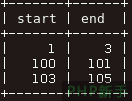
1. Numerical auxiliary table
Numerical auxiliary table is a simple table containing only N integers from 1 to N. N is usually very large. The numeric auxiliary table is a very powerful tool, so we create a persistent numeric auxiliary table:
CREATETABLENums( a INTUNSIGNED NOTNULLPRIMARYKRY
)ENGINE=InnoDB;
CREATEPRODURE CreateNums (t INTUNSIGNED ) BEGIN DECLAREs INTUNSIGNED DEFAULT1; TRUNCATETABLENums; INSERTINTONums SELECTs; WHILE s*2 <= t DO
BEGIN INSERTINTONums SELECTa+s FROMNums; SETs = s*2 END; ENDWHILE; END; 2. Continuous range
CREATETABLEt (a INTUNSIGNED NOTNULLPRIMARYKEY); INSERTINTOt VALUES(1); INSERTINTOt VALUES(2); INSERTINTOt VALUES(3); INSERTINTOt VALUES(100); INSERTINTOt VALUES(101); INSERTINTOt VALUES(103); INSERTINTOt VALUES(104); INSERTINTOt VALUES(105);
How to get the following output result?

SELECTMIN(a) start,MAX(a) endFROM( SELECTa,rn,a-rn ASdiff FROM(SELECTa,@a:=@a+1 rn FROMt,(SELECT@a:=0) ASa) ASb )ASc GROUPBYdiff;
3. Minimum missing value
Click (here) to collapse or open
CREATETABLEx( a INTUNSIGNED PRIMARYKEY, b CHAR(1) NOTNULL )ENGINE = InnoDB; INSERTINTOx SELECT3,'a'; INSERTINTOx SELECT4,'b'; INSERTINTOx SELECT6,'c'; INSERTINTOx SELECT7,'d';
Note that column a must be a positive integer, so the type here is INT UNSGINED. The problem with minimum missing values is that assuming column a starts at 1, for data 3, 4, 6, 7 in the current table, the query should return 1. If the data in the current table is 1, 2, 3, 4, 6, 7, then 5 is returned.
The solution is as follows:
SELECT CASE WHENNOTEXISTS (SELECTa FROMx WHEREa=1)THEN1 ELSE (SELECTMIN(a)+1 ASmissing FROMx ASA WHERENOTEXISTS (SELECT* FROMx ASB WHEREA.a+1=B.a)) ENDASmissing;
Run the above SQL and get the result 1. If you insert 1 and 2 into column a, the result will be 5.
To fill in the minimum missing value, the solution is as follows:
INSERTINTOx SELECT CASE WHENNOTEXISTS (SELECTa FROMx WHEREa=1)THEN1 ELSE (SELECTMIN(a)+1 ASmissing FROMx ASA WHERENOTEXISTS (SELECT* FROMx ASB WHEREA.a+1=B.a)) ENDASmissing, 'p';
Run the above SQL, we will insert 5 in column a and 'p' in column b.
4. Get the row number
The row number refers to the consecutive integer assigned to the rows of the query result set in order.
CREATETABLEsales ( empid varchar(10) NOTNULL, mgrid varchar(10) NOTNULL, qty` int(11) NOTNULL, PRIMARYKEY(empid) ); INSER INTOsalses VALUES('A',Z',300); INSER INTO salses VALUES('B',X',100); INSER INTOsalses VALUES('C',Y',100); INSER INTO salses VALUES('D',Z',300); INSER INTOsalses VALUES('E',X',200); INSER INTO salses VALUES('F',Z',100);
Now we perform line number statistics based on empid
SELECTempid, (SELECTCOUNT(*) FROMsales AST2 WHERET2.empid <= T1.empid) ASrownum FROMsales AST1;




